
How America invaded GP racing's Golden Age
The USA's multi-discipline national championship taught riders a wide range of skills
Eras come, and eras go. Like the Mughals. It may seem far-fetched to compare the dominance of US grand prix racers to a century-odd of regional rule, but that’s how it felt from 1977 all the way through to 1993. Like a small army of Valentino Rossis.
It started with a big surprise from Cal Rayborn—whose career was tragically cut short by a fatal accident in 1973—and tailed off 20 years later after Wayne Rainey crashed terminally. In between, the Stars and Stripes all but replaced the chequered flag, but for the plucky intervention of a handful of Australians. How did it happen? What did it mean? And why did it come to an end?
There are many answers to the first question, but one above all others: The USA’s multi-discipline national championship taught riders a wide range of skills; especially, how to keep on going fast when the tyres don’t grip. However, their Grand National Series also kept them isolated. Thus Rayborn’s prowess came as something of a surprise to the European establishment. After all, everybody knew that US racers were accustomed to putting one foot down in the corners.
The Grand National championship was, until 1989, a multi-discipline series, and was centred around oval dirt-tracks, on horse trotting tracks at fairgrounds scattered far and wide across the vast continent. Riders became very good at turning left, wearing a steel shoe on that foot to help slide along the packed dirt of the mile and half-mile tracks; the rear wheel producing a plume of dust—the fabled rooster tail.
There were four different dirt-track disciplines, including so-called TT races, more like European scrambles, in that the tracks turned right as well as left, and included jumps. And the occasional road race for good measure.
Europe was devoted to tarmac—with its own heroes like Mike Hailwood and Giacomo Agostini—and, through the 1960s, to Japanese machines. Meanwhile, America’s AMA series went its own sweet way. The twain would meet once a year at Daytona, Florida, for the 200-mile race, but the banked circuit was unique, a one-off annual event that was a holiday race for the GP establishment and was won by US riders right up until 1973, when Finnish hero Jarno Saarinen claimed a first victory for Yamaha.
Things were starting to change, and not only for Europe. By that year, double Daytona winner Cal Rayborn had already served notice. Californian Rayborn rode for Harley-Davidson, and road-racing was his forte. In 1971, Triumph-BSA—under increasing attack from Japan—conceived the Anglo-American Match Races in Britain as a promotional one-make event pitting those scorned Americans against Britain. The next year, the series was opened to any machines, and Rayborn arrived on his Harley-Davidson, a humble V-twin based on a road engine. He was seeing the tracks for the first time. Furthermore, Americans didn’t race in the rain, of which at least some could be guaranteed.
Rayborn won three of the six races: He had arrived.
For 1974, he was given a factory Suzuki contract to race in GPs, but over the winter he went to race in New Zealand, mainly to embark on a four-wheel career, but also taking the chance to get used to a two-stroke. His borrowed Suzuki seized at the Pukekohe Park Raceway, he was thrown into the barrier, and killed instantly.
His death left the American challenge on hold for a while, although there were others to take it up. One was Gary Nixon, who also got a contract with Suzuki, only to sustain severe injuries in pre-season testing in Japan.
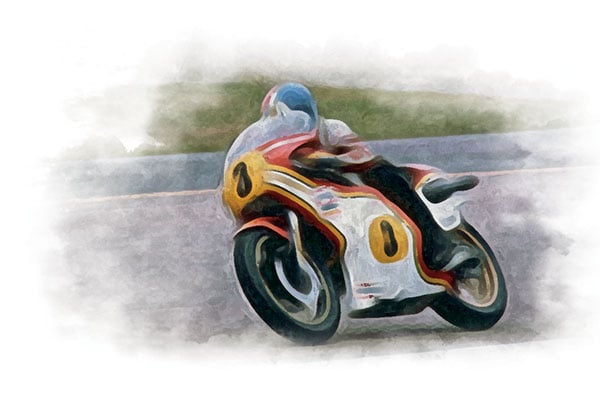
The man who took Nixon’s place on the factory Suzuki team, alongside soon-to-be champion Barry Sheene, was another Californian, Pat Hennen. To him would fall the first national honours. In his first season, 1976, he became the first US rider to win a premier-class GP. It happened in Finland, and would be the first of three over his three years in GP racing. But the few wins were backed by strong results. In 1976, he finished third overall, with Sheene first; and the same again the following year.
By then, he had become a thorn in the side of his illustrious team-mate. Sheene did everything he could to ensure that the Suzuki team was centred around him, but it wasn’t working. Hennen was fast, and not easily fooled.
By 1978, a new force had arrived: Kenny Roberts. But the battle between the Yamaha rider and the Suzuki pair was still close after the first six races—Roberts led by just six points. And the rider lying second was Hennen, another four points clear of Sheene and still in with a chance of the title. It all ended abruptly on the Isle of Man. Hennen, first man to lap in under 20 minutes, was racing there for a second time, on a GP Suzuki.
The reason for his high-speed crash was never explained. The results were very definite: Severe injuries left him in a coma for many weeks, and his top-level racing career was over.
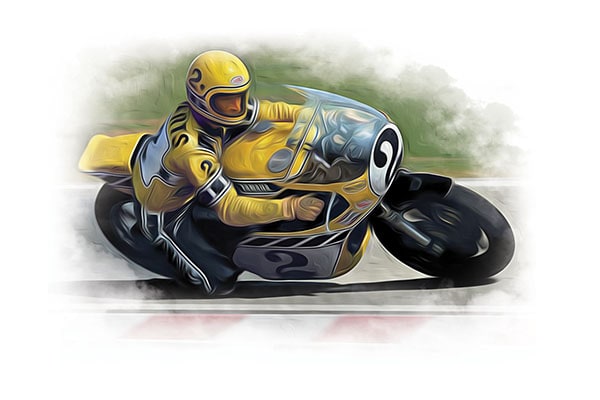
King Kenny
There was another pioneer who arrived in 1977: Slim, bespectacled Steve Baker. Signed by Yamaha, he won Daytona, and became the first American World Champion, with the Formula 750 title. He was second (between Sheene and Hennen) in the more important 500cc championship.
But Baker remains something of a footnote. In 1978, he was obliged to make way at Yamaha for Roberts; and at the end of the year his career was cut short by a serious crash, at Mosport Park in Canada.
Now came the first real headline act. The first serial winner. The first US grand prix world champion. And a true giant of racing. Kenny Roberts. And he had already won the Grand National championship, twice.
A demon slider on the dirt and an enthusiast for handlebar-to-handlebar close combat, he was also a natural at road-racing. The facts were not necessarily unrelated.
He was not quite unknown in Europe when he won Yamaha’s backing to take on the World Championship in 1978. He was a genuine GP rookie, having never even seen most of the circuits, and a stranger to the enforced nomadic lifestyle.
His attack was two-fold. He entered both, 250 and 500 classes, the former as an aid to learning the tracks. It was on the little bike that he achieved his first success: Debut victory in Venezuela. But it was not enough to earn him an entry for the next round in Spain; as an ‘unknown’, he had to turn up and argue long and hard. He promptly qualified on pole at the Circuito del Jarama, and finished second in the race.
Another 250 pole and another win followed before he concentrated on the 500, where he had taken the overall lead with a second consecutive win after only the fourth round.
Roberts’ technique was made for the contemporary generation of 500s: Spitting erratic horsepower that overwhelmed the spindly chassis and overworked the tyres. Once the handling loosened up, the dirt-tracker came into his own.
Roberts would talk about “steering with the rear wheel”; by which he meant he was using the inevitable wheelspin in the same way as a flat-tracker. The rooster-tail remained in the abstract, but the technique paid off.
He dominated the championship for three years, from 1978 to 1980.
He might have won more, but for circumstances including running out of fuel at one race and suffering food poisoning at another that meant he was third and fourth in 1981 and 1982, with two more GP wins each year.
In 1983, came a battle royal as he added another six to bring his total to 22. It was not enough. The Californian superstar was second, by just two points. A new force had arrived, from the other side of America: Fast Freddie Spencer.
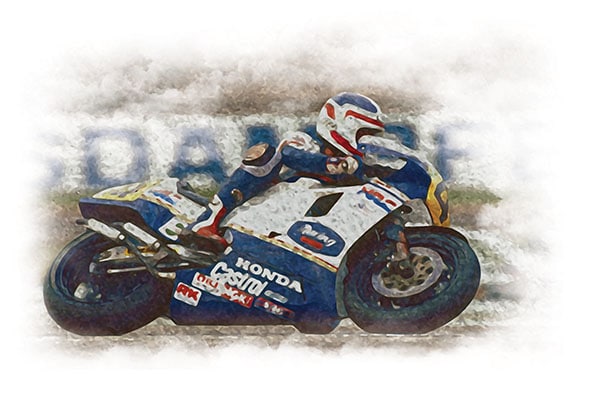
In many ways, the most remarkable, Spencer was always a bit of a puzzle. Mild manners and choirboy looks combined with a devastating turn of speed. Most impressive was his power of taking a strong lead from the start, while others nursed their tyres up to temperature. A contemporary recalls: “On the warm-up lap, Freddie would front, tucking it under. Any other rider would have crashed, but for him it meant he had the tyre warm when the flag dropped.”
Spencer’s striking ability to crash without falling off is echoed today by the rider who has broken all his “youngest-ever” records: Marc Marquez. Spencer became the youngest 500-class winner, aged 20, in 1982, and the youngest champion in 1983, still 21, with that remorseless battle against Roberts.
Roberts’ last Yamaha V4 was a difficult bike, with good top speed but a peaky engine. Honda’s first-ever GP two-stroke was a handy V3 with roots in motocross, and consequently good bottom-end and mid-range. Plus it was light and wieldy.
The next year, Honda went V4, and slightly mad. The first NSR’s exhaust expansion chambers looped over the top of the engine, baking the rider and making a simple plug change a finger-burning nightmare. The fuel was slung underneath. Worst of all, the first NSR had carbon composite wheels. At the first race, at Kyalami, Spencer claimed pole... and then the rear wheel broke. He crashed, broke his ankle, and his title defence was off to a bad start.
By the end of the season, Spencer switched back to the doughty V3. But it was too late; Eddie Lawson took his first title. 1985 was Spencer’s landmark. He took on both 250 and 500 classes, and won both, the first such double champion in history. And the last, in any categories. Spencer was rampant: Seven of his 20 500-class wins came in 1985, and he took seven 250 wins as well.
And then, puzzlingly, it was all over. Spencer burned out, physically and mentally. He never won another race. He came back spasmodically the next year, but his star time was over. It had been truly meteoric.
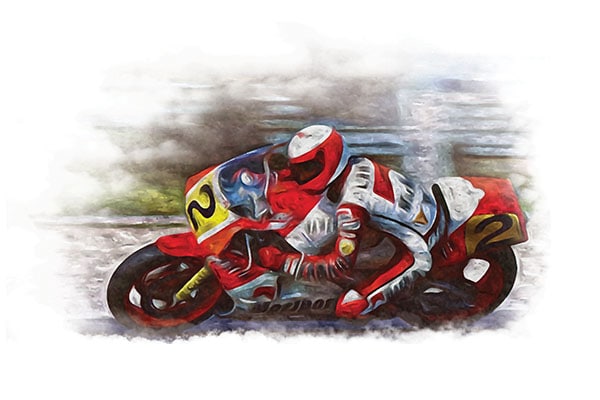
Steady Eddie
After Roberts retired at the end of 1983, Spencer was not short of competition. US Superbike champion Eddie Lawson, another Californian, would become a giant of the sport. His first season, 1983, was disappointing, when he was hired by Yamaha to ride shot-gun to Roberts, with a new two-stroke 500 cc YZR Yamaha. Taking points away from Spencer proved impossible.
In 1984, Lawson came into his own, defeating Spencer, and winning the title every even year, ceding it to Wayne Gardner in 1987.
Riding the factory Marlboro Yamaha, he took 26 wins. His style was smooth and consistent and very, very reliable; a contrast to Spencer’s celestial power ballet: Steady Eddie.
Then in 1989, a sensation. At the last minute, he switched from Yamaha to Honda, and triumphed: The first-ever to win back-to-back titles on different makes of motorcycles. His fourth crown put him among the greats. And though he wasn’t burned out, the new opposition was strong, and things didn’t quite click, as he rejoined Yamaha in 1990.
His career ended with two years on the slowly improving Cagiva. “If we’re not careful, we’ll make this thing competitive,” he told me, early on. Sure enough; Lawson gave the Italian marque its first race win, in Hungary in 1992.
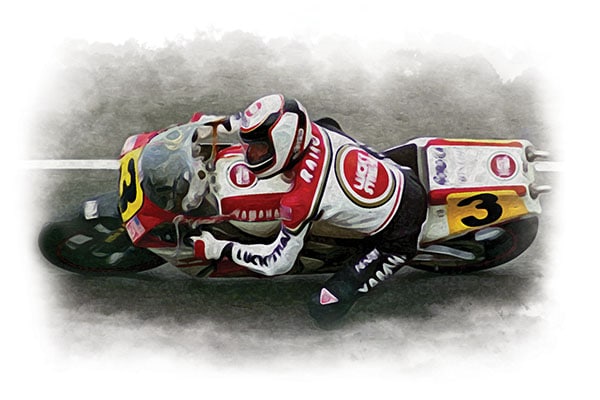
The man who beat Lawson had raced with him for years before, from childhood on the many Californian junior dirt-tracks, through the American system into superbikes, and eventually to GPs. Wayne Rainey was always a couple of years behind, but always a threat.
It came to fruition in 1990. Rainey essayed a single 250 year in 1984; returned on a 500 in 1988, winning the first of 24 races that year on the satellite Team Roberts Lucky Strike Yamaha. In 1989, the title was between him and Lawson on the Honda. It went the way of his older racing rival after a rare race crash in Sweden.
From 1990, Rainey came into his own. He took the title for three years straight, although not without a fight (see Kevin Schwantz). But nobody fought harder than Rainey, and when the odds were against him—as when the Yamaha had a year of bad handling or a badly broken leg—he just fought harder.
Rainey was an intense figure on a motorcycle. He had plenty of natural talent, but if there were any gaps he made up for them by hard work. He polished his skills constantly, worked tirelessly on his fitness, and fought back from injury with blatant courage and determination.
Who knows how many more titles Rainey would have won? In 1993, a tough season, he had regained the title lead with just three races to go. He was on target for four in a row when disaster struck at Misano. His only comfort was that he was on the gas and leading the race when he crashed. The near-fatal impact broke his back. With typical obduracy, he survived, and came back to racing as a team manager. But he was paralysed from the chest down, and would never ride a motorcycle again.
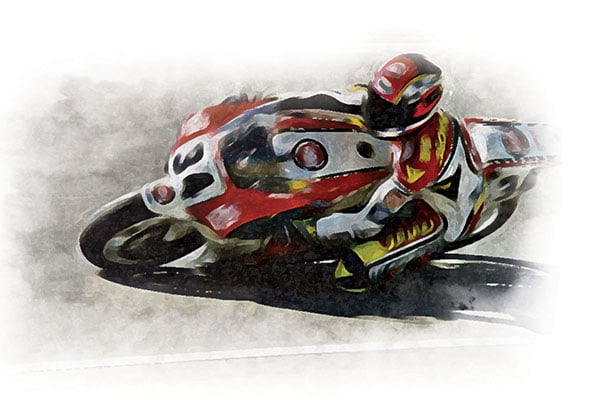
Kevin Schwantz was the last of the line, the great surge of talent that had come out of the US dirt-tracks. Funnily enough, however, he hadn’t.
The Texan had cut his teeth as a motocrosser, before switching to road racing already aged 20, and showing a precocious natural talent as well as an unforgettably spectacular style.
Background and geography apart, he was a member of that generation, and instantly joined in at the top level. US Superbike Racing was, to a large extent, between him and Rainey. They were deadly rivals, from the day they met: Rainey was smooth, fast and steadfast, at least by comparison; Schwantz was all skill, all daring. Like Spencer before him, he seemed able to get away with almost anything.
Kevin was a Suzuki man from the start, and after a couple of highly impressive outings on the old square four, he joined the factory GP squad as they returned with an all-new V4, the RGV, in 1988.
By coincidence, rival Rainey had arrived at the very same time, and Schwantz gained bragging rights from the start, by winning the opening round at Suzuka Circuit.
The Schwantz-Rainey battle raged on without remission over the next four years. Schwantz won 25 races, one more than Rainey. But his derring-do got the better of him just too often for him to put a title campaign together. He didn’t often crash out the lead, but it was often enough to cost him his chances, over and over.
He finally did win the title in 1993, after Rainey had crashed out terminally. He told me at the time: “I’d rather not be champion than for Wayne to be hurt.” It was a bitter-sweet victory. By then, Schwantz was pretty beat up: Most especially his oft-broken left wrist. Weakened and mentally sapped, he soldiered on for another year, winning two more races.
Then, in 1995, halfway through the season, he called it a day. By then, racing had become a chore, and the expectation put upon him an unbearable burden. Ironically, the realisation came after he had flown back from the opening round at Japan, always previously a favourite race, sitting alongside Rainey, who had advised him to think of himself rather than his obligations.
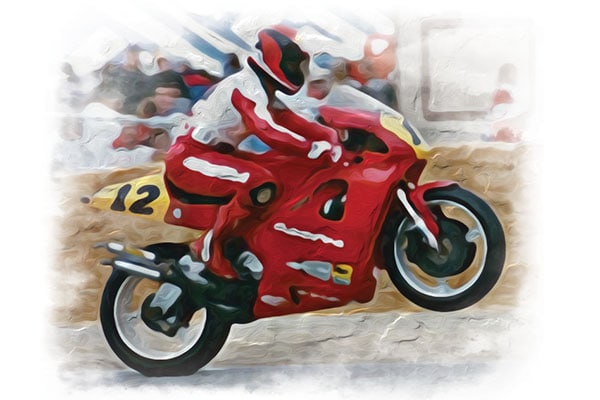
Randy Mamola
There was one other giant of the era, and though Randy Mamola never did win a title, he was runner-up no less than four times, and the Californian’s spectacular style and cheeky persona combined with 13 wins between 1979 and 1987 made him unforgettable.
It was Mamola’s misfortune not only that his prime coincided with that of Kenny Roberts, but also that he was Suzuki’s factory rider at a time when the doughty square-four RG500 was on the skids. There wasn’t much wrong with it, but the opposition was getting stronger.
The margins in racing are small (as you can see today with Ducati’s performance over the past few years); but they make all the difference.
Mamola left Suzuki at the end of 1983, signed up for Honda... but only as a second-string rider, on the three-cylinder, while Spencer had the four. After two years, he returned to Yamaha, to the new Kenny Roberts team, but again his timing wasn’t what it might have been.
The Lucky Strike-backed squad was one step below the official Marlboro squad, where Eddie Lawson had taken over from Roberts. He was third, and second again.
Thereafter, Mamola remained as the Clown Prince of racing. Signed up by Cagiva for three years, on a bike some way short of the Japanese opposition, he concentrated on being entertaining. Nobody pulled bigger wheelies, nobody spun the rear and slid the tail out as much as him. He did give the Italian marque its first rostrum, in a wet Belgian race in 1988.
The rest
These are not the only US World Champions. But the next was a different generation. Kenny Roberts Junior had elected to go road-racing, his father’s support was (said the King) initially reluctant, but always wholehearted. After a 250 season of some promise, he came to 500s in his dad’s Modenas team, and was ultimately shepherded into the Suzuki factory team. Kenny won the title fair and square in 2000, from a first-year Rossi. It went downhill from there, until his career petered out on the uncompetitive Suzuki MotoGP four-stroke.
Nicky Hayden, 2006 champion, had more in common with the old brigade. He’d cut his teeth dirt tracking, and furthermore was AMA Superbike Champion. The reward was a slot in the factory team. His title battle came with just two wins, and was against Rossi. It came to a last-race showdown... and Rossi blinked first. Hayden remained a frequent rostrum visitor, with Ducati after Honda, and remains a dedicated contender in 2015, aiming to be top Open Bike.
There were others. Mike Baldwin, who partnered Mamola in the early days of Lucky Strike Yamaha, was a rider of note. And then there was John Kocinski. The befreckled rider from Little Rock, Arkansas, was a true eccentric, whose personal orbit overlapped with racing, but was not concentric. Kocinski won a convincing 250 title, but in three years on the factory Yamaha, won only two races. More impressively perhaps, he won two more after moving to Cagiva. Kocinski later added a World Superbike title, before retiring to become a multi-millionaire property developer and design guru in Beverley Hills.
As with all his fellow American GP winners, racing was richer for his presence.
(This story appears in the 30 November, -0001 issue of Forbes India. To visit our Archives, click here.)





